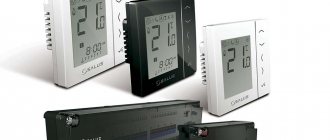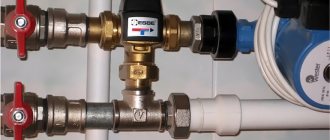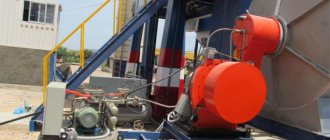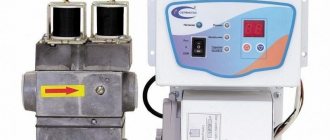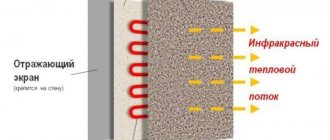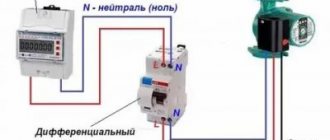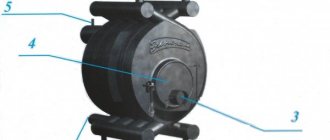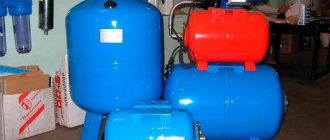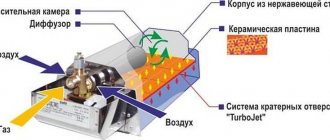Home / Boiler automation
Back
Published: 05/24/2019
Reading time: 3 min
0
2101
Modern scientists, together with engineers, are searching for increased efficiency of heating systems in order to reduce the negative consequences affecting our environment. One way to solve this problem is weather-dependent automation that can control heating systems.
This group of devices is capable of monitoring fuel consumption in a running unit, taking into account current weather changes. In this case, it is possible to predict excessive cooling or excess temperature in a heated room in order to immediately compensate for possible deviations.
It is important to understand that the work carried out by weather-compensated automation is aimed at maintaining the optimal balance between a comfortable microclimate and an economical heating mode.
- 1 Weather-compensating automation device
- 2 Operating principle
- 3 Advantages and disadvantages
- 4 When weather-compensated automation comes in handy
Benefits of automatic control
Nowadays, it is difficult to imagine a modern boiler room without automation systems that combine all the new achievements in the field of heat flow control. It is characteristic that for most consumers the main criterion for the quality of a heating system is still the principle of “it heats or does not heat.” Despite the fact that it is completely inapplicable to automated heating systems, few people recognize the importance of using special automation in their boiler room, which would ensure the maximum level of thermal comfort in the house.
Currently, only a modern thermal control system can significantly reduce heating costs and at the same time create the most favorable temperature background in the house. This effect is achieved by optimizing the operation of all components of the heating system. Note that almost all modern boilers are equipped as standard with standard automation, which controls the operation of the burner, receives signals from sensors and safety devices, and also maintains the set temperature of the coolant in the circuit. It is important to note: it is the “boiler” temperature, not the room temperature. This does not relieve the user of the need to constantly adjust this temperature depending on the need for heat.
Using such imperfect equipment, you involuntarily doom yourself to be eternally “chained” to the thermostat knob: when the outside temperature drops, the water in the system will need to be heated more, and when it gets warmer outside, it will need to be lowered. And you can do these manipulations with the thermostat ad infinitum. But if during cold weather you have to “start up” the boiler willy-nilly, then when it warms up, as often happens, it seems that it is not necessary to reduce the temperature of the boiler water. After all, as you know, heat doesn’t break your bones. And there are still many among us who like to open the window wider when the room gets too hot.
It is obvious that such an approach to energy saving will significantly hit the pockets of even the wealthiest homeowner in a short time. And primarily due to excessive fuel consumption. But the trend of rising prices for basic energy resources, which has clearly manifested itself in recent years, according to experts, will continue in the future. Naturally, there can be no talk of any thermal comfort with such methods of thermal regulation. According to experts, the user of a boiler that is not equipped with an automation system spends more than 210 hours of personal time per year just on adjusting the temperature of the coolant in the boiler! Another thing is modern microprocessor control panels. They allow you to maintain different temperatures in several heating circuits at once. Such a circuit is understood as a part of the system that operates with its own temperature and hydraulic characteristics and has the ability to adjust them. This is, say, a radiator heating circuit or one circuit of water heated floors. For example, the Immergas system for the Victrix line of boilers controls three independent circuits (two mixing and one direct) and a DHW circuit, and Color Matic from VAILLANT has the ability to control the operation of fifteen at once, and the temperature of the coolant inside them directly depends on the weather conditions outside.
Systems with this principle of regulation are called weather-controlled or, as experts say, weather-dependent (we will talk about the principle of weather-dependent control below). To control the outside temperature, these systems use an outdoor temperature sensor installed on the outside of the building, on the north side. The system controller (programmer) is also fully responsible for the process of preparing hot water in an indirect heating boiler.
Some systems use the principle of modular construction. It allows you to customize the system for a specific situation and customer requirements, as well as connect additional circuits and control their operation by installing the appropriate module - without replacing the control panel as a whole, which provides significant cost savings.
Advantages and disadvantages
Since such a system is not cheap, you need to know exactly what advantages it will give to the owner who decides to install it. Among them:
- the ability to maintain a constant temperature in the house regardless of sudden changes in external temperature;
- significant savings in fuel resources are achieved;
- advance control of the boiler power eliminates its operation at extreme conditions;
- harmful emissions into the atmosphere are reduced, especially noticeable at extreme conditions;
- the service life of heating equipment increases.
Energy savings are especially noticeable in apartment buildings with a large area of wind-blown facades.
The system also has disadvantages:
- high price;
- difficulty in choosing the location for installing the internal sensor and fine-tuning the heating balancing;
- the need to attract specialists for repairs and periodic maintenance.
Weather-dependent automation is guaranteed to pay for itself in multi-storey buildings and large cottages. In small private homes, cost effectiveness varies greatly depending on local conditions.
Heating circuits
The implementation of automated weather-compensated heating is complicated by the fact that in modern practice it is necessary to manage not just one heating circuit at home, but a system with several circuits. Let's try to characterize them.
- There is almost always a radiator heating circuit. To control it effectively, it is necessary to maintain the supply line temperature between 50-85°C. Sometimes several such circuits are installed, for example, on different floors of a house, and the temperature in them can also be different.
- If independent electric or gas water heaters are not installed, then, as a rule, a high-temperature (up to 70-85°C) heating circuit for the hot water boiler is provided. The temperature of the coolant in it must be constant.
- Requirements for comfort are constantly growing, and today many consumers order the additional installation of one or more water-heated floor circuits. These are low-temperature systems with variable supply line temperature (30-55°C).
- If you have a swimming pool, you will probably want to have warm water in it. For this purpose, a special circuit for heating the water in the pool can be installed. It is high-temperature, with a constant coolant temperature °C.
- Similar to heating a swimming pool, a heating circuit for supply air is installed in the heat exchanger of the ventilation system. But, according to the design, the coolant temperature here does not have to be constant.
Water flow through the radiator and underfloor heating circuit can be variable. This happens in cases where thermostatic valves with thermal heads are installed on radiators, the function of which is to change the coolant flow through them and, accordingly, through the entire heating circuit as a whole. In the same way, separate thermostats can be installed on the distribution manifold of the underfloor heating system.
When will weather-compensating automation be useful?
There are devices called convectors. Externally they are very similar to radiators, but their properties are strikingly different.
The main advantage of convectors is their quick response to temperature changes. In 3-5 minutes they are able to warm up the room. During the same time they are able to change the temperature.
If there are heating convectors, weather-compensating automation will implement its function as efficiently as possible.
Principle of weather-compensated heating control
Let us explain how room temperature is maintained taking into account changes in outside temperature. When setting up the controller, a so-called temperature curve is established, reflecting the dependence of the temperature of the coolant in the heating circuit on changes in weather conditions outside. This curve is a line, one point of which corresponds to +20°C outside (in this case, the temperature of the coolant in the heating circuit is also +20°C, since it is believed that under such conditions there is no need for heating). The second point is the coolant temperature (say, 70°C), at which even on the coldest day of the heating season the temperature in the room will remain set (for example, 23°C). If the building is not insulated sufficiently, a slightly higher temperature of the coolant in the heating circuit will be required to compensate for heat loss. Accordingly, the slope of the curve will be steep. And vice versa, if everything is in order with the thermal insulation of the house. When making a controller, many similar curves are entered into the device’s memory so that you can then select from the entire family the appropriate line specifically for the conditions of your home.
As a rule, to create the maximum level of thermal comfort, as well as to save fuel, a single street sensor is not enough. Therefore, an additional sensor is often installed inside a heated room. The presence of two sensors at once, both indoor and outdoor, allows you to accurately monitor and quickly adjust the temperature in the premises of the house.
Typically, a room temperature sensor is installed in the so-called reference room - the temperature in it will correspond to your concept of a comfortable thermal background. This room should not be heated by direct sunlight or exposed to drafts. As a rule, children's and bedrooms are chosen as a standard. Installing a room sensor makes it possible to enable the self-adaptation mode, in which the heating curve is selected for the appropriate room automatically - by the microcomputer of the control panel itself. In addition, a room sensor is often integrated into a thermostat, with which you can set the desired temperature and its average level throughout the house. Local temperature control in a single room is achieved by installing thermostatic valves with thermal heads on radiators.
A very important aspect of using a thermostat is, again, fuel economy. Let us explain how it is carried out. Let’s say that guests gathered in the room where the sensor is installed and the temperature increased by 2°C due to the natural heat generation of people. The control panel detects these changes and gives a command to reduce the temperature of the coolant in this circuit, although the street sensor may require just the opposite. Reducing the heat consumption to heat this room naturally saves fuel. But there are also problems here. Flooding the fireplace in the room where the thermostat is set, or leaving a window open for too long, can change the temperature throughout the house. To take into account such factors, many systems provide the possibility of making amendments to the control algorithm by setting the coefficient of influence of the room sensor on the nature of the heating curve. But in general, experts simply do not recommend installing room temperature measuring devices near fireplaces, entrance doors, windows and other sources of heat or cold that can introduce an error in the measurement results.
It should also be noted that installing only a room thermostat, without an outside temperature sensor, significantly increases the inertia of the temperature control system. Changes in the thermal background will occur with a delay, since the automation will begin to operate only when the temperature in the house, for example, drops, and this will happen later than the actual cold snap outside.
Modern controllers not only monitor the weather, but also have a fairly large number of functions, some of which are user, and some are service. If the former guard comfort, the latter monitor the condition of the system and ensure the correct and safe operation of the equipment.
Pump control from an external signal
Connecting the controller to the smart home system significantly expands the heating control capabilities. In addition to the heating operation under the control of a weather-compensated automation controller, the system’s owners have the opportunity to remotely adjust the temperature in the premises.
The main condition here is connecting the controller to the Internet and installing a special application on mobile devices to control life support systems at home.
Boiler room piping diagrams and principles of circuit control
In order to organize the operation of one or more heating circuits in a hydraulic system, they must be connected to a heat generator-boiler. This problem can be solved in different ways; experts call them boiler room piping schemes. Let's consider the most common of them, as well as the principles of organizing the corresponding management process with all their advantages and disadvantages.
Heating circuits are divided into direct and mixing according to the method of achieving temperature in them. The water temperature in the direct circuit is achieved only by the burner and depends on the duration of its operation.
In the mixing circuit, the temperature of the coolant is determined both by the operation of the burner and by the position of the damper of the actuator - a three-way mixing valve with a servo drive. By resorting to the first option, you can easily connect a low-temperature boiler with one radiator heating circuit and ensure automated control of it depending on the outside temperature. This is a very simple and relatively inexpensive task. If, in addition to heating, it is necessary to organize hot water supply, without resorting to mixing units, two types of schemes are used. The first is with a three-way valve, the second scheme is with two pumps.
The simplest is the circuit with a three-way switch valve equipped with a servo drive. Water from the boiler is directed to the tap, which, in turn, directs it either to the heating circuit or to the boiler heating circuit. Switching can be carried out by command from the boiler control panel. The water temperature in the boiler is controlled automatically using a temperature sensor installed in it. As soon as the water cools below the required level, a command is given to switch the three-way tap. It is necessary to take into account that with such a piping and control scheme, while heating water in the boiler, the heating is turned off (that is, it is impossible to organize control of hot water supply with mixed priority).
The collector circuit, as the name suggests, involves the use of collectors for piping the boiler room, which are pipes with leads to the required number of circuits. This scheme, being quite simple, has become widespread due to the advent of so-called quick installation components. They include pumping and mixing groups. These devices allow you to quickly assemble a system with several heating circuits (it takes a few days to install a boiler room). However, it should be noted that such modules are used mainly for boiler houses of small power - up to 85 kW.
Nevertheless, they are extremely convenient for installation and significantly reduce the risk of error due to the notorious human factor, since they are assembled and tested for functionality and tightness in the factory.
There is an interesting option for piping boiler rooms using a hydraulic separator (hydraulic arrow). This refers to a scheme of primary and secondary rings, the operating principle of which is as follows: boiler water constantly circulates through a small circuit (primary ring), from which other heat consumers (various circuits) take the coolant with the help of circulation pumps. The advantage of this scheme is the ability to connect a large number of secondary circuits while ensuring the nominal flow rate through the boiler and the relative simplicity of the design.
The DE DIETRICH company (France) recommends using a thermohydraulic distributor (abbreviated as THR) for piping its boilers. When using it, a constant flow of coolant through the heating device is achieved - regardless of the value of water flow in the heating circuits, where this indicator may vary. As a result, it is possible to achieve optimal balanced operation of the boiler and heating circuits.
It is important to note that automation from many manufacturers allows you to control the boiler and circuits in a wide variety of boiler room piping schemes. However, it is still better to entrust the search for the most suitable option and the selection of automation to a specialist.
Custom Functions
User functions primarily include various heating programs that allow you to adapt the heating mode of the house to the rhythm of life of its inhabitants (sleep and wakefulness, vacations, shift work). Programs for hot water supply are selected in the same way. If the user is not satisfied with any of the standard set offered by the manufacturer, you can create your own individual one - both for heating and for hot water supply.
Good night mode. Almost all systems have the ability to set the so-called night temperature. Scientists have proven that a sleeping person feels much more comfortable when the room temperature drops slightly (usually by 4°C) relative to the daytime room temperature (obviously, this reaction was formed in people during evolution and reflects their adaptation to natural temperature changes during the day and night hours). At the same time, all thermal processes are inertial, and if, for example, you set the start time of the day program at the time of your awakening, then when you get out of bed, you will feel some discomfort due to the fact that the room has not yet had time to warm up after the night. To overcome this shortcoming, many modern controllers use a room pre-heating mode (sometimes called a soft exit from night mode), according to which the temperature in the house begins to gradually rise a few hours before you wake up. For example, controllers of the Diematic family from DE DIETRICH or Logamatic 4000 from BUDERUS have a similar function.
Low temperature systems. At the current level of development of heating technology, there is a tendency to switch to low-temperature heating modes. In other words, to a decrease in the operating temperature of heating devices. This leads to a more comfortable perception of thermal radiation by humans. The most important advantage of the low-temperature mode is the reduction in fuel consumption. The installation of automation also allows you to operate the heating system in low-temperature mode.
By the way, here we should separate concepts such as low-temperature mode and low-temperature boiler. A low-temperature boiler is a device in which, due to the specific properties of the materials used in its manufacture, or thanks to original technical solutions, it is possible to maintain the flow temperature at a level of up to + 40 ° C (as, for example, iroVIT VKO boilers from VAILLANT) and even less - up to + 30°C (for GT 210 boilers from DE DIETRICH). In this case, the return line temperature is not regulated at all.
Low-temperature heating mode can be achieved without using a low-temperature boiler, but for this you will need actuators - three or four-way mixing valves with a servo drive, which will be discussed separately. In combination with them, the heating boiler will operate in constant mode with a high boiler water temperature, and the temperature in the heating circuits will depend on the degree of opening of the mixing valve, in which hot water is mixed with cold, return water.
Priority system. One of the important functions of automatic control systems is the ability to organize hot water supply control. It can be priority, mixed and non-priority. The most common, priority method is not without its drawbacks: when hot water is consumed, the heating system simply turns off. This usually does not cause the house to become colder. The mixed priority method allows you to use for heating the house that part of the boiler power that is not used for preparing hot water. However, if there is insufficient power, the entire resource is spent on the latter. And what “non-priority hot water supply” is can be understood already from the name.
Disinfection. The software of many control panels allows thermal disinfection of the boiler once a week. This is done by raising the temperature in the boiler to 80°C for 20-30 minutes. This procedure eliminates the possible presence of legionellosis bacteria in the water, which causes pneumonia.
Frost protection. As soon as the outside temperature drops below a certain value, the automation itself will start the boiler and maintain a certain temperature in the heating system to prevent it from defrosting.
"Smart House". The latest models of controllers provide the ability to both remotely access themselves via a telephone line or GSM mobile connection, as well as their integration into the Smart Home system. This option is available in devices from such heating equipment manufacturers as VIESSMANN, BUDERUS, DE DIETRICH, etc. Such devices allow you to remotely control the temperature in the house and find out about any problems in time.
Thermostat ZONT
Weather-compensated heating regulator ZONT H-1 is an intelligent system, remotely controlled via GSM or the Internet. The device is connected via a mobile application, personal account on the manufacturer’s website or via SMS commands. Thermostat capabilities:
- 2G SIM card management;
- transmission of temperature sensor readings and boiler operating mode;
- selection of heating control curve;
- programming room heating for a week;
- notification of errors and emergencies;
- message about a power outage in the house;
- transaction history for 3 months;
- software update via the Internet.
The thermostat is connected in 2 ways - through the terminals on the boiler or with an adapter to the digital bus. Heating control can be performed in relay mode, with periodic switching on of the gas burner. Digital control is possible via an adapter - electronic flame modulation.
Technical characteristics of ZONT H-1:
- operating voltage 10-28 V;
- analog and digital inputs;
- connection of 10 wired and radio sensors;
- operating range from –30 to +55°C;
- exit to mode – 50 seconds;
- plastic case, universal surface mounting.
Actuators
In order to organize the operation of several heating circuits with different, not always constant temperatures, actuators are required. The most common are three- and four-way mixing valves (mixers). The principle of their operation is to regulate the temperature of the coolant in a separate heating circuit by mixing water from the boiler with water from the return line. Thus, the temperature of the coolant in the supply line of the circuit can vary from a minimum, for example equal to room temperature, to a maximum, equal to the temperature of the boiler water, but not higher than it. The crane can be turned manually (but then there is no need to talk about any automation of control!) or using a special motor - a servo drive.
Typically, several parameters of servo drives are indicated in the technical data sheet. This is the power supply voltage, the maximum torque generated on the shaft, and the speed of the drive. The last indicator reflects the time it takes for the servo drive to transition from one extreme position to another. This is usually from 60 to 300 seconds. It is worth keeping in mind that a shorter response time of the servo drive does not at all guarantee a rapid change in temperature in the heating circuit. Let us remember that all thermal processes are very inertial. It is for this reason that drives with operating speeds of less than 60 seconds are not usually used. Approximately this amount of time is required for the sensor installed on the supply pipe, the temperature of which cannot change instantly, to respond to changes in the temperature of the coolant. In the service menu of many control panels there is a setting parameter that takes into account the speed of the servo drive. For example, in the control panels of the Logamatic 4000 series from BUDERUS, costing € 1,270, the opening time of the three-way mixing valve in seconds is directly set as standard. This indicator characterizes the response of a particular servo drive and is reflected in the data sheet.
Mixing taps and actuators for them are produced by a number of manufacturers, for example ROCA, Honeywell, WOLF. The valve body can be made of either cast iron or brass. Both materials are well suited for use in heating systems. Mixers from the Swedish company ESBE have proven themselves to be excellent. A three-way mixing valve with a diameter of 32 mm, manufactured by this company, can be purchased for € 60-70, a servo drive for it will cost € 150-170.
Operating rules
During operation, you must comply with all requirements and recommendations of the manufacturer. Self-diagnostic tools are built into modern systems, and they themselves can inform the owner about any problems that have arisen. This does not replace the need for periodic inspections and preventative maintenance. During preventive maintenance, the reliability of fastening and cleanliness of sensors, especially external ones, should be checked, and the actuators of the system should be tested. During quarterly prevention, it is also convenient to change the seasonal algorithm of the device.
Service functions
Fresh air. To reduce the amount of harmful emissions into the air, multifunctional automation can optimize the operation of the burner. In the installation parameters of modern controllers, the minimum combustion duration is set initially. This eliminates the operation of the burner in the “start-stop” mode, which has a bad effect on both the service life of the equipment and the environment. The fact is that most harmful emissions are generated precisely at the moment of ignition. This occurs due to incomplete combustion of fuel. By default, the minimum burner operating time is usually at least one minute. So, by purchasing a modern management system, you take care not only of your wallet, but also of your health.
Smooth start. An interesting feature is the so-called start-up relief. When the boiler is turned on for the first time (cold) or after a long period of inactivity, increased condensation formation is usually observed in the furnace. As a rule, this is a mixture of acids that adversely affect the internal elements of the device. It is to eliminate this unpleasant phenomenon that many control systems allow for starting unloading. Its essence lies in the fact that immediately at the moment the heating is turned on, the circulation pumps are not yet working, so the coolant in the boiler quickly heats up to 40-60°C. It is this range that is considered safe in terms of condensation formation, which means that the time of the harmful effects of the latter is significantly reduced. After reaching the desired temperature, the heating circuit pumps are turned on and the system begins to operate in the specified mode.
Pump run-out. In many modern systems, it is possible to set the pump run-on time. This function allows you to prevent possible overheating of the boiler. The fact is that in boilers (especially cast iron) there is an increase in the temperature of the boiler water after the burner is turned off. This is due to the heat exchange occurring inside the metal, directed from the surface facing the firebox to the one that is washed by the coolant. The process will continue until the temperatures of the internal and external surfaces are equal, and the boiler may overheat. This is why it is important not to stop the circulation pumps immediately, but to let them run for some time.
An interesting way to solve this problem was proposed by BUDERUS specialists in the Logamatic 4000 series panels, creating the “use of residual heat” function. When heating the coolant, the boiler does not reach a maximum temperature, but only a certain design temperature, at which the automation turns off the burner, and heating continues due to the effect described above. The energy released, of course, is not wasted, but is used to produce hot water in the boiler.
Summer maintenance. Many control systems have a pump release feature. It is implemented, for example, in the E6 series controllers from KROMSCHRODER (cost € 382), in Vitotronic control panels from VIESSMANN, Honeywell Smile, Immergas Viktrix and many others. A circulation pump and mixing valve that does not work for a long time can jam, which is why in the summer, during prolonged inactivity, it is advisable to turn them on for a while.
